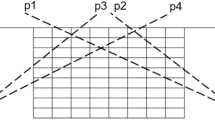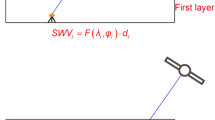Abstract
Tropospheric wet delay, the main source of which is water vapor, is one of the major factors affecting the accuracy of positioning techniques using microwave. Tropospheric tomography is a powerful method to reconstruct the water vapor content in four-dimensional (4D) space. This paper studies the effect of using function-based and voxel-based tropospheric tomography methods on the positioning accuracy. This examination is performed on the static and kinematic positioning modes using Global Navigation Satellite Systems (GNSS) stations under different weather conditions. After validating the results of tomography methods using radiosonde observations, the tomography-based positioning solutions, including function-based and voxel-based approaches, are compared with the positions obtained using tropospheric models. The results of two GPS stations show that the accuracy increases when applying tomography approaches. The function-based tomography is able to increase the accuracy of the up component of the static and kinematic modes by about 0.42 and 0.79 cm, respectively, compared to the voxel-based method. In addition, the use of the function-based tropospheric tomography can decrease the convergence time of the kinematic Precise Point Positioning (PPP) solution.
Highlights
-
The first attempt to evaluate the efficiency of troposphere tomography in different positioning techniques including static and kinematic.
-
Comparison of the accuracy of the voxel-based and function-based tomography techniques.
-
Comparison of the effect of using tomography approaches with conventional and traditional tropospheric correction methods in increasing the accuracy of positioning.
-
Study of the effect of using voxel-based and function-based troposphere tomography and other approaches in increasing the convergence speed of kinematic positioning.














Similar content being viewed by others
Data availability statement
All the GPS data used in this paper are publicly available in the UNAVCO data portal (https://www.unavco.org/data/gps-gnss/data-access-methods/dai2/app/dai2.html). The reanalysis data, ERA-Interim product, are released by ECMWF at https://www.ecmwf.int/.
References
Adavi Z, Weber R (2019) Evaluation of virtual reference station constraints for gnss tropospheric tomography in Austria region. Adv Geosci 50:39–48. https://doi.org/10.5194/adgeo-50-39-2019
Amerian Y, Hossainali MM, Voosoghi B (2013a) Regional improvement of IRI extracted ionospheric electron density by compactly supported base functions using GPS observations. J Atmos Sol Terr Phys 92:23–30. https://doi.org/10.1016/j.jastp.2012.09.011
Amerian Y, Voosoghi B, Mashhadi Hossainali M (2013b) Regional ionosphere modeling in support of IRI and wavelet using GPS observations. Acta Geophys 61(5):1246–1261. https://doi.org/10.2478/s11600-013-0121-5
Bender M, Stosius R, Zus F et al (2011) GNSS water vapour tomography – Expected improvements by combining GPS, GLONASS and Galileo observations. Adv Space Res 47:886–897
Bevis M, Businger S, Herring TA, Rocken C, Anthes RA, Ware RH (1992) GPS meteorology: Remote sensing of atmospheric water vapor using the Global Positioning System. Journal of Geophysical Research: Atmospheres 97(D14):15787–15801
Brenot H, Rohm W, Kačmařík M, Möller G, Sá A, Tondaś D, Champollion C (2020) Cross-comparison and methodological improvement in GPS tomography. Remote Sensing 12(1):30
Böhm J, Niell A, Tregoning P, Schuh H (2006) Global Mapping Function (GMF): A new empirical mapping function based on numerical weather model data. Geophys Res Lett 33(7):L07304. https://doi.org/10.1029/2005GL025546
Böhm J, Heinkelmann R, Schuh H (2007) Short Note: A global model of pressure and temperature for geodetic applications. J Geodesy 81(10):679–683. https://doi.org/10.1007/s00190-007-0135-3
Böhm J, Kouba J, Schuh H (2008) Forecast Vienna Mapping Functions 1 for real-time analysis of space geodetic observations. J Geodesy 83:397–401
Chen G, Herring TA (1997) Effects of atmospheric azimuthal asymmetry on the analysis of space geodetic data. J Geophys Res 102(B9):20489–20502. https://doi.org/10.1029/97JB01739
Chen BY, Liu ZZ (2014) Voxel-optimized regional water vapor tomography and comparison with radiosonde and numerical weather model. J Geod 88:391–703. https://doi.org/10.1007/s00190-014-0715-y
Dach R, S Lutz, P Walser, P. Fridez (2015) Bernese GNSS Software Version 5.2. User manual, Astronomical Institute, University of Bern, Bern Open Publishing. DOI: https://doi.org/10.7892/boris.72297; ISBN: 978–3–906813–05–9.
Dahmen W, DeVore R, Scherer K (1980) Multi-Dimensional spline approximation. SIAM J Numer Analy 17(3):380–402
Davis J, Elgered G, Niell AE, Kuehn CE (1993) Ground-based measurement of gradients in the wet radio refractivity of air. Radio Sci 28:1003–1038
Dee DP et al (2011) The ERA-Interim reanalysis: configuration and performance of the data assimilation system. Q J R Meteorol Soc 137(656):553–597. https://doi.org/10.1002/qj.828
Douša J, Eliaš M (2014) An improved model for calculating tropospheric wet delay. Geophys Res Lett. https://doi.org/10.1002/2014GL060271
Flores A, Ruffini G, Rius A (2000) 4D tropospheric tomography using GPS slant wet delays. Ann Geophys Ger 18:223–234
Gao Y, Chen K (2005) Performance analysis of precise point positioning using real-time orbit and clock products. J Glob Position Syst 3:95–100
Gao Y (2006) GNSS solutions: Precise point positioning and its challenges. Inside GNSS November/December, 16–18.
Hadas T, Kaplon J, Bosy J, Sierny J, Wilgan K (2013) Near-real-time regional troposphere models for the GNSS precise point positioning technique. Meas Sci Technol 24:055003
Haji-Aghajany S, Voosoghi B, Yazdian A (2017) Estimation of north Tabriz fault parameters using neural networks and 3D tropospherically corrected surface displacement field. Geomat Nat Hazards Risk 8:918–932
Haji-Aghajany S, Amerian Y (2017) Three dimensional ray tracing technique for tropospheric water vapor tomography using GPS measurements. J Atmos Solar Terr Phys 164:81–88. https://doi.org/10.1016/j.jastp.2017.08.003
Haji-Aghajany S, Amerian Y (2018) Hybrid regularized GPS tropospheric sensing using 3-D Ray tracing technique. IEEE Geosci Remote Sens Lett 15:1475–1479. https://doi.org/10.1109/LGRS.2018.2853183
Haji-Aghajany S, Amerian Y (2020a) Atmospheric phase screen estimation for land subsidence evaluation by InSAR time series analysis in Kurdistan, Iran. J Atmos Solar-Terr Physi. https://doi.org/10.1016/j.jastp.2020.105314
Haji-Aghajany S, Amerian Y (2020b) Assessment of InSAR tropospheric signal correction methods. J Appl Remote Sens 14(4): 044503. https://doi.org/10.1117/1.JRS.14.044503
Haji-Aghajany S, Voosoghi B, Amerian Y (2019) Estimating the slip rate on the north Tabriz fault (Iran) from InSAR measurements with tropospheric correction using 3D ray tracing technique. Adv Space Res 64:2199–2208
Haji-Aghajany S, Amerian Y, Verhagen S, Rohm W, Ma H (2020a) an optimal troposphere tomography technique using the WRF model outputs and topography of the Area. Remote Sens 12:1442. https://doi.org/10.3390/rs12091442
Haji-Aghajany S, Amerian Y, Verhagen S (2020b) B-spline function-based approach for GPS tropospheric tomography. GPS Solut 24:88. https://doi.org/10.1007/s10291-020-01005-x
Hansen PC (1997) Rank-deficient and Discrete Ill-posed Problems. Numerical Aspects of Linear Inversion, Monographs on Mathematical Modeling and computation, Vol. 4, SIAM, Philadelphia.
Heroux P, Kouba J (2001) GPS precise point positioning using IGS orbit products. Phys Chem Earth 26:573–578
Herring TA, King RW, McClusky SC (2010) GPS Analysis at MIT, GAMIT Reference Manual, Release 10.5. (Department of Earth, Atmospheric, and Planetary Sciences Massachusetts Institute of Technology, Cambridge MA, available on line at http://wwwgpsg.mit.edu/~simon/gtgk/GAMIT_Ref.pdf accessed 12 May 2015).
Heublein M, Alshawaf F, Ba E, Zhu X, Hinz S (2019) Compressive sensing reconstruction of 3D wet refractivity based on GNSS and InSAR observations. J Geodesy 93–2:197–217
Hirahara K (2000) Local GPS tropospheric tomography, earth planet. Space 52:935–939
Hopfield HS (1969) Two-quartic tropospheric refractivity profile for correcting satellite data. J Geophys Res 74:4487–4499
Ibrahim HE, El-Rabbany A (2011) Performance analysis of NOAA tropospheric signal delay model. Meas Sci Technol 22:115107
Jolivet R, Agram PS, Lin NY, Simons M, Doin MP, Peltzer G, Li Z (2014) Improving InSAR geodesy using global atmospheric models. J Geophys Res Solid Earth 119:2324–2341. https://doi.org/10.1002/2013JB010588
Li X, Zhang X, Ge M (2011) Regional reference network augmented precise point positioning for instantaneous ambiguity resolution. J Geodesy 85:151–158
Lou Y, Huang J, Zhang W, Liang H, Zheng F, Liu J (2017) A New Zenith tropospheric delay grid product for real-time PPP applications over China. Sensors 18:65
Lu C, Zus F, Ge M, Heinkelmann R, Dick G, Wickert J, Schuh H (2016) Tropospheric delay parameters from numerical weather models for multi-GNSS precise positioning. Atmos Meas Tech 9:5965–5973
Lyard F, Lefevre F, Letellier T, Francis O (2006) Modelling the global ocean tides: modern insights from FES2004 Ocean Dyn, 56: 394–415, https://doi.org/10.1007/s10236-006-0086-x
Ma H, Verhagen S (2020) Precise point positioning on the reliable detection of tropospheric model errors. Sensors 20:1634
Mautz R, Ping J, Heki K, Schaffrin B, Shum CK, Potts L (2005) Efficient spatial and temporal representations of global ionosphere maps over Japan using B-spline wavelets. J Geodesy 78:660–667
Möller G, Landskron D (2019) Atmospheric bending effects in GNSS tomography. Atmos Meas Tech 12:23–34. https://doi.org/10.5194/amt-12-23-2019
Perler D, Geiger A, Hurter F (2011) 4D GPS water vapor tomography: new parameterized approaches. J Geodesy 85(8):539–550
Ray RD, Ponte RM (2003) Barometric tides from ECMWF operational analyses. Ann Geophys 21(8):1897–1910. https://doi.org/10.5194/angeo-21-1897-2003
Rohm W, Bosy J (2009) Local tomography troposphere model over mountains area. Atmos Res 93:777–783
Rohm W, Zhang K, Bosy J (2014) Limited constraint, robust Kalman filtering for GNSS troposphere tomography. Atmos Meas Tech 6:1475–1486
Saastamoinen J (1973) Contributions to the theory of atmospheric refraction. Part II: refraction corrections in satellite geodesy. Bull Geod 107:13–34
Sadikin R, Swardiana I and Wirahman T (2017). Cubic spline interpolation for large regular 3D grid in cylindrical coordinate: (Invited paper)," 2017 International Conference on Computer, Control, Informatics and its Applications (IC3INA), Jakarta, Indonesia, 2017, pp. 1–6 https://doi.org/10.1109/IC3INA.2017.8251730.
Shi J, Xu C, Guo J, Gao Y (2014) Local troposphere augmentation for real-time precise point positioning. Earth Planets Space 66:30
Wilgan K, Hadas T, Hordyniec P, Bosy J (2017) Real-time precise point positioning augmented with high-resolution numerical weather prediction model. GPS Solut 21(3):1341–1353
Yao Y, Yu C, Hu Y (2014) A new method to accelerate PPP convergence time by using a Global Zenith Troposphere delay estimate model. J Navig 67:899–910
Yao Y, Zhao Q (2016) Maximally using GPS observation for water vapor tomography. IEEE T Geosci Remote 54:7185–7196
Yu W, Chen B, Dai W, Luo X (2018) Real-time precise point positioning using tomographic wet refractivity fields. Remote Sens 10:928
Zhao Q, Yao Y, Yao W, Xia P (2018) An optimal tropospheric tomography approach with the support of an auxiliary area. Ann Geophys 36:1037–1046. https://doi.org/10.5194/angeo-36-1037-2018
Zumberge JF, Heflin MB, Jefferson DC, Watkins MM, Webb FH (1997) Precise point positioning for the efficient and robust analysis of GPS data from large networks. J Geophys Res 12:5005–5017
Acknowledgements
Authors would like to appreciate the UNAVCO for the GPS observations. We are also grateful to the ECMWF for publishing ERA-Interim data.
Author information
Authors and Affiliations
Contributions
S.H-A,Y.A and W.R conceptualized the study. S.H-A and Y.A processed data and prepared the paper draft. S.V, H.S and W.R substantially contributed to the interpretation of results and provided many useful suggestions in the internal review process. All authors were involved in result discussions throughout the development.
Corresponding author
Rights and permissions
About this article
Cite this article
Haji-Aghajany, S., Amerian, Y., Verhagen, S. et al. The effect of function-based and voxel-based tropospheric tomography techniques on the GNSS positioning accuracy. J Geod 95, 78 (2021). https://doi.org/10.1007/s00190-021-01528-2
Received:
Accepted:
Published:
DOI: https://doi.org/10.1007/s00190-021-01528-2




